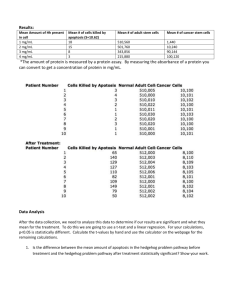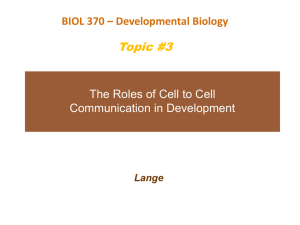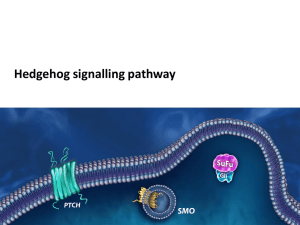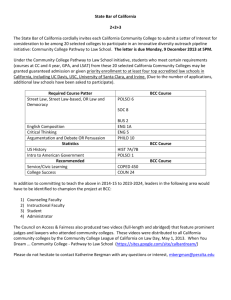Cancer Handout
advertisement
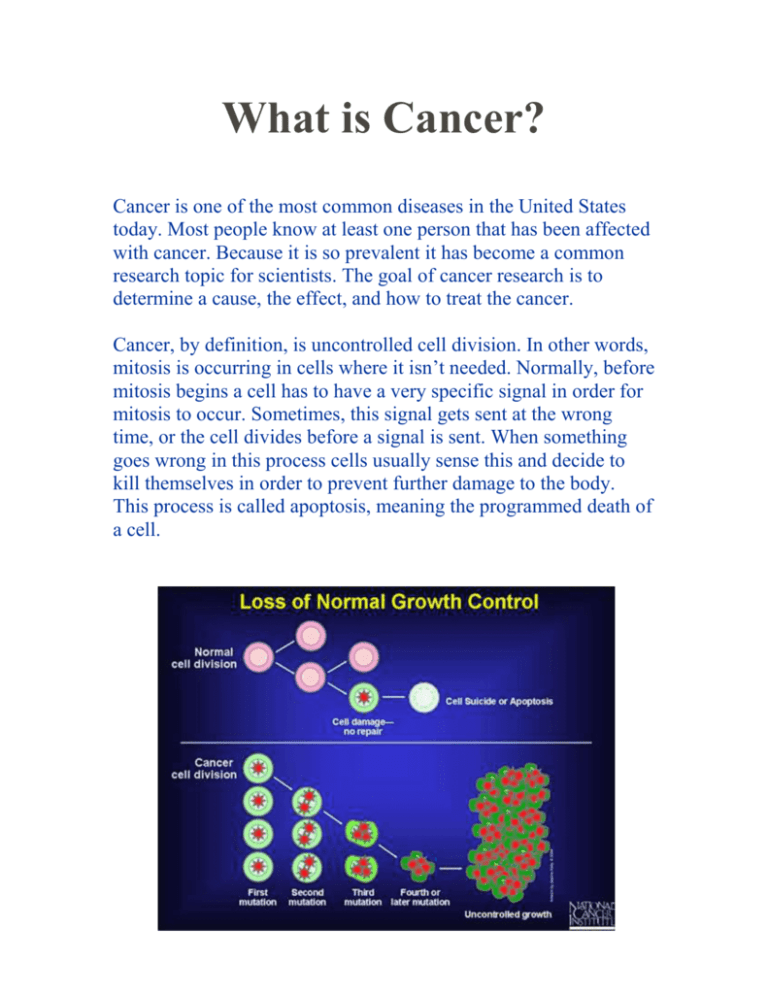
What is Cancer? Cancer is one of the most common diseases in the United States today. Most people know at least one person that has been affected with cancer. Because it is so prevalent it has become a common research topic for scientists. The goal of cancer research is to determine a cause, the effect, and how to treat the cancer. Cancer, by definition, is uncontrolled cell division. In other words, mitosis is occurring in cells where it isn’t needed. Normally, before mitosis begins a cell has to have a very specific signal in order for mitosis to occur. Sometimes, this signal gets sent at the wrong time, or the cell divides before a signal is sent. When something goes wrong in this process cells usually sense this and decide to kill themselves in order to prevent further damage to the body. This process is called apoptosis, meaning the programmed death of a cell. Usually you would think a cell dying is a bad thing, but this isn’t the case in apoptosis. Why would apoptosis be helpful to our health? What do you think would happen is something blocked apoptosis? How Does Hedgehog Cause Cancer? After many years of research a huge connection between sonic hedgehog and cancer was found. Basal Cell Carcinoma is one of the most common types of skin cancer in humans. It is estimated that there are about 2.8 million cases of Basal Cell Carcinoma (BCC) in the US each year. BCC is a tumor that grows on your skin. It often starts out looking like skin irritation or eczema and then continues to grow. Luckily, BCC tumors rarely metastasize to vital organs and it is not usually life threatening. However, the early BCC is caught the more effective treatment is. If the BCC tumor is left for too long it can cause damage to surrounding tissues. Scientists discovered that when hedgehog was expressed at the wrong time, adult stem cells were transformed into cancer stem cells that grew into a tumor. This discovery offered a huge promise for a potential cancer treatment. If scientist could discover a way to inhibit sonic hedgehog they could possible prevent basal cell carcinoma. To understand the connection we have to look deeper into the hedgehog pathway. There are three important proteins in the hedgehog pathway we need to understand in order to understand how it promotes cancer. Overall, this pathway controls when and where cells divide, or undergo mitosis. But how does this cause cancer? Smoothened (SMO) is a protein that signals a cell to enter mitosis and divide. Patched (PTCH) is a protein that inhibits smoothened. Hedgehog (Hh) inhibits patched. Here is a graphic describing the normal state in most of your cells. Here, hedgehog is not active so cells are not dividing: If something goes wrong with transcription or translation, Hedgehog can become active at the incorrect time. This causes cells to divide. Look at the graphic below to see how activation of the hedgehog pathway leads to cell division. In the box below, use your knowledge of protein pathways to model the relationship between these two proteins. From your model you can see how if hedgehog is expressed at the wrong time, cells will begin to divide. The definition of cancer in unregulated cell division. When hedgehog is activated at the wrong time, cells begin to divide uncontrollably. Those cells ball up together and form a tumor. This is what causes cancer. Take a look at the cell below to see how these proteins work together to affect your cells and body (Similar to parts of a car!) Apoptosis Hedgehog has another important role in causing cancer. Not only does it promote uncontrolled cell division but it also decreases apoptosis. Apoptosis is when a cell decides to kill itself. At first this may seem like a bad thing, but apoptosis is crucial to keeping the human body healthy. When a cell senses something go wrong it kills itself before causing any harm. Unfortunately, when hedgehog is activated apoptosis is blocked. This means the cells divided uncontrollably cannot kill themselves like they normally would. This allows even more cells to become cancerous and form a tumor. *Images from:http://www.hedgehogpathway.com/home/hedgehogpathway/hedgehog-signalling.html How Do We Treat Cancer? Now that we understand how a problem in the hedgehog pathway can cause cancer, we can begin to think about possible treatments. If improper activation of the hedgehog pathway causes uncontrolled cell division and decreased apoptosis, then the logical way to treat that would be to block that pathway. This is exactly what scientists thought that lead them to a treatment for basal cell carcinoma. Vismodegib is a treatment that was approved by the FDA in 2012 to treat basal cell carcinoma. Vismodegib works by blocking the hedgehog pathway. This means it works with hedgehog, patched, and smoothened to block their activities and begin to control cell division again. The brand name of this medication in the US is Erivedge. To understand the affects Vismodegib has on the proteins in the hedgehog pathway you have to think back to how these proteins interact with each other. Look at your model for the hedgehog pathway. If Vismodegib blocks hedgehog what happens to the other proteins? In the data analysis section you will be asked to predict levels of protein after treatment. Keep your model handy as well as your knowledge of the Vismodegib treatment.
